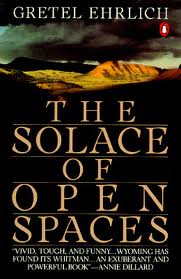It's May and I've just awakened from a nap, curled against sagebrush the way my dog taught me to sleep -- sheltered from wind.
A front is pulling the huge sky over me, and from the dark a hailstone has hit me on the head. I'm trailing a band of two thousand sheep across a stretch of Wyoming badlands, a fifty-mile trip that takes five days because sheep shade up in hot sun and won't budge until it's cool. Bunched together now, and excited into a run by the storm, they drift across dry land, tumbling into draws like water and surge out again onto the rugged choppy plateaus that are the building blocks of this state.
Description:
Sometimes the title of a book can be an indicator of its quality just like its first sentence. Any author who can create the phrase, The Solace of Open Spaces, offers the hope of a story worth hearing, one written in an imaginative, poetic style. This particular title promises a description of the healing peace found in a vast, quiet setting, and its author, Gretel Ehrlich, delivers on this promise with this memoir of her years in a small town in mountains of Wyoming.
In The Solace of Open Spaces, Ehrlich paints a quiet, but deeply intense portrait of the people and environment she encounters in Self, Wyoming, population 50, in the late 1970s. Originally in Laramie to make a film for PBS on sheepherders, she experiences a personal crisis which compels her to stay and recover by living and working alongside these same sheepherders and ranchers.
Knowing nothing about this kind of life, she observes and slowly absorbs the physical and mental ways of survival from these long-time sheep men and women living in the isolation of the Wyoming mountains.
Over the months, she learns to rope and ride, to pull lambs from ewes during difficult births, to live outdoors, and even to herd sheep alone in sub-zero weather. And she soon finds "living with animals makes us redefine our ideas about intelligence."
It is the people who make the strongest impressions. From the heavy drinkers to the drifting cowboys (often the same men), from women struggling to keep families together to ranchers moving tens of thousands of sheep to spring pastures, these individuals pull us into their lives. Facing harsh weather, isolation, and economic difficulties, they know "it's not toughness but 'toughing it out' that matters in this environment."
Ehrlich find the cowboys she works beside to be unlike the popular image of the strong, silent, heroic individualist. These are men who must work as a team with other cowboys, horses, dogs, and sheep to accomplish huge tasks or just to survive. They are only silent "when there is no one else to talk to." And when one rides off into the sunset, it's because "he's been on horseback since four in the morning moving cattle and he's trying, fifteen hours later, to get home to his family."
Ehrlich is a contemplative, poetic writer of her own emotions as well as a keen observer of the people and land around her. Her descriptions are spare, honest, and beautifully written, providing an episodic, yet thoroughly enveloping narrative about a world and people rarely portrayed. From meteor showers she observes at 2am from the bed of her pickup truck to the rodeos watching her friends ride, her descriptions are of real people doing real work and living in a real environment that is as hostile as it is beautiful.
It is a an impassionate, yet compelling world she describes, one filled with strong people.
Everything in nature invites us constantly to be what we are. We are often like rivers: careless and forceful, timid and dangerous, lucid and muddled, eddying, gleaming, still.Yes, such a world and people are very much worth reading about, especially when portrayed by a skilled observer and writer like Ehrlich.
Happy reading.
Fred
_______________
If this book interests you, be sure to check out:
Ehrlich, Gretel. A Match to the Heart: One Woman's Story of Being Struck By Lightning
During her life in Wyoming, Ehrlich is struck by lightning. Her memoir of that experience, both physically and mentally, are unique, revealing and compelling. Fantastic reading.
Young, Carrie. Nothing To Do But Stay
Memoir of a woman settler on the plains of North Dakota as told by her daughter in a warm narrative that shows the strength and character of the people who faced tremendous challenges and joys in this life in the early 1900's.
Houston, Pam. Cowboys Are My Weakness
Stories of men and women and their relationships in the wilds of Colorado told by a romantic, untamed, no-holds-barred storyteller.
